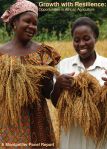 Last month the Montpellier Panel presented the report on ‘Growth with Resilience: Opportunities in African Agriculture’. The report’s vision states:
Last month the Montpellier Panel presented the report on ‘Growth with Resilience: Opportunities in African Agriculture’. The report’s vision states:
“The challenge is to generate agricultural growth that produces enough food, ensures it is accessible to all, is inclusive of the most vulnerable and is resilient, and hence able to withstand the increasing multiple stresses and shocks that afflict the world.
To this end, we believe the priority should be supporting the creation of:
- Resilient markets that enable farmers to increase production and generate income through innovation and taking risks, while ensuring food is available at an affordable price.
- Resilient agriculture that creates agricultural growth out of knowledge and innovation, while simultaneously building the capacity of smallholder farmers to counter environmental degradation and climate change.
- Resilient people who are able to generate diverse livelihoods that provide stable incomes, adequate nutrition and good health in the face of recurrent stresses and shocks.
To achieve these goals we will also need political leadership that demonstrates the necessary vision and will”.
The report is available from the Imperial College London website
